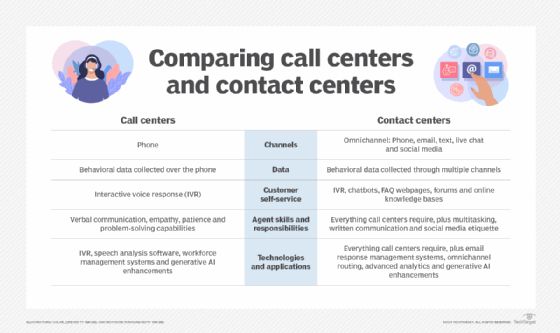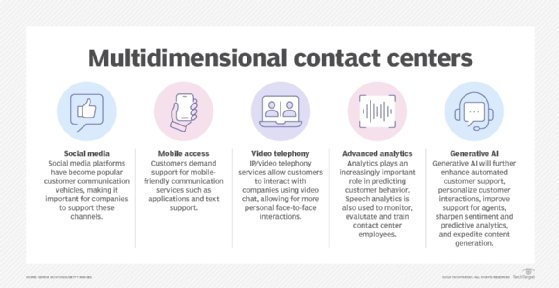Call center vs. contact center: What's the difference?
Call centers still live and die by the phone, while time and technologies have demanded more complex contact centers that service customers over multiple channels of communication.
Although the terms call center and contact center are sometimes used interchangeably, there are major differences, including technologies, channels of communication, types of customer data collected, self-service options, workflows and agent responsibilities.
Call centers were once the gold standard for customer service, but new technologies emerging over time, plus the aftereffects of the COVID-19 pandemic, changed the way many businesses operated and interacted with customers. As analog and simple telephone communication gave way to multiple digital channels, many call centers by necessity morphed into more complex, multifunctional contact centers.
A call center consists of customer service professionals, known as call center agents, who handle inbound and outbound calls. Agents who take inbound calls help customers with account inquiries, scheduling, technical support, complaints and questions about products and services. Outbound calls focus on telemarketing, fundraising, lead generation, scheduling, customer retention and debt collection. Call centers play a role in customer experiences by providing dependable and timely customer service through a historically reliable channel -- the phone.
While many contact centers include a call center, they also handle communication through various digital channels, such as text, email, social media, voice over IP, live chat and chatbots. Using multiple channels, companies can collect more marketing data and enable customers to interact with the business in more convenient ways.

Call centers vs. contact centers
Call centers and contact centers provide customer service and outreach, but they differ in several key areas, including channels of communication, types of customer data collected, customer self-service (CSS) capabilities, agent skills and job requirements, and technologies and applications.
Channels of communication
Call centers emerged at a time before digital channels and they continue to use the phone as the major channel of communication. Still, they benefit many businesses because phone calls with live agents can offer a personalized experience that other channels often lack. However, the multiple channels provided by contact centers offer customers the convenience of interacting with a company on the channel of their choice.
Types of customer data collected
Because contact centers provide more communication channels than call centers, they can collect more diverse customer data, enhance customer profiling, provide targeted customer support and improve customer experiences. Contact centers, for example, can use social media data to determine customer affiliations and attitudes that might not be apparent over the phone. Still, call centers can use speech analysis software to analyze phone calls and gain some degree of insight into a customer's behavior and buying patterns.
Customer self-service
For CSS capabilities, most call centers use interactive voice response (IVR) systems -- automated phone assistants that respond to voices and keypad entries. IVR systems can route callers to relevant agents and perform simple tasks, such as reorders, but they can also annoy customers with lengthy menu options that fail to address specific needs. Contact center CSS goes beyond IVR and includes chatbots, FAQ webpages, forums and online knowledge bases to help customers resolve inquiries independently. Contact center CSS can also provide automated text messages that confirm or cancel appointments and mobile applications where customers can place or change orders. CSS tools can help reduce customer wait times, live agent workloads and operating costs.
Agent skills and job requirements
Customer service skills and experience are essential for call center and contact centers agents to solve problems and provide customers with the intangibles of empathy, patience and friendliness. Contact center agents require additional skills to handle interactions over multiple channels, including phone, email, live chat, text messaging and social media. Their job might require reading comprehension, sound writing skills, social media etiquette and multitasking capabilities.

Technologies and applications
Aside from the basic requirements of phones, computers and headsets, call center technologies include the following:
- IVR. Automated phone assistants select the right agent or department to service a customer based on voice and keypad responses.
- Automated call distributor (ACD) After an IVR determines the best route for the caller, an ACD automatically transfers the caller to that agent or department.
- Speech analysis software. These tools can analyze calls to detect customer emotions, such as satisfaction and anger. They also determine when to follow up with unsatisfied customers.
- Workforce management (WFM) system. Certain days in a call center can be busier than others. WFM systems can schedule the appropriate number of agents for each day.
- Enhanced internet access. Agents who work remotely need a fast and secure connection to use call center software, which might require internet upgrades.
Although some call center and contact center technologies overlap, the multifunctional aspects of contact centers, together with generative AI's penetration into several aspects of the contact center, dictate implementing additional technologies and applications, including the following:
- Email response management system. These systems can organize, track and archive large volumes of emails.
- Omnichannel routing. Because contact centers use multiple channels, agents might struggle to manage various interactions. Omnichannel routing uses AI to identify a customer's intent and forward all requests to a live agent, regardless of the channel.
- Advanced analytics. This capability includes various AI technologies and analysis techniques, providing a holistic view of the customer journey and predictive insights into a customer's future choices.
- Channel reports. Reporting software collects raw data across channels to create key performance indicators (KPIs), such as first contact resolution and customer effort scores Managers can monitor KPIs to ensure quality assurance across channels.
Generative AI will further enhance automated customer support through chatbots and virtual assistants, personalize customer interactions with tailored responses and natural language processing, improve support for agents with real-time assistance and simulation training, sharpen customer sentiment analysis and predictive analytics, and expedite content generation for FAQs and knowledge bases.
Editor's note: This article has been updated to provide the latest information on call centers and contact centers.
Tim Murphy is an associate site editor for TechTarget's Customer Experience and Content Management sites.
Ron Karjian is an industry editor and writer at TechTarget covering business analytics, artificial intelligence, data management, security and enterprise applications.





